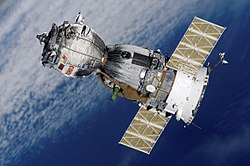This article needs additional citations for verification .(May 2008) |
 TM-32 undocks on October 31st, 2001 | |
| Operator | Rosaviakosmos |
|---|---|
| COSPAR ID | 2001-017A |
| SATCAT no. | 26749 |
| Mission duration | 185 days, 21 hours, 22 minutes, 40 seconds |
| Orbits completed | ~3,025 |
| Spacecraft properties | |
| Spacecraft type | Soyuz-TM |
| Manufacturer | RKK Energia |
| Crew | |
| Crew size | 3 |
| Launching | Talgat Musabayev Yuri Baturin Dennis Tito |
| Landing | Viktor M. Afanasyev Claudie Haigneré Konstantin Kozeyev |
| Callsign | Криста́лл (Kristall) |
| Start of mission | |
| Launch date | April 28, 2001, 07:37:20 UTC |
| Rocket | Soyuz-U |
| End of mission | |
| Landing date | October 31, 2001, 05:00:00 UTC |
| Landing site | Near Arkalyk 46°44′58″N69°42′58″E / 46.74944°N 69.71611°E |
| Orbital parameters | |
| Reference system | Geocentric |
| Regime | Low Earth |
| Perigee altitude | 193 kilometres (120 mi) |
| Apogee altitude | 247 kilometres (153 mi) |
| Inclination | 51.6 degrees |
| Period | 88.6 minutes |
| Docking with ISS | |
| Docking port | Zarya nadir |
| Docking date | 30 April 2001 07:58 UTC |
| Undocking date | 19 October 2001 10:48 UTC |
| Time docked | 172d 2h 50m |
| Docking with ISS (Relocation) | |
| Docking port | Pirs nadir |
| Docking date | 19 October 2001 11:04 UTC |
| Undocking date | 31 October 2001 01:38 UTC |
| Time docked | 11d 14h 34m |
  Soyuz TM-32 Taxi crewmembers in the Zvezda Service Module Soyuz programme (Crewed missions) | |
Soyuz TM-32 was a crewed Soyuz spaceflight which was launched on April 28,2001,and docked with the International Space Station two days later. It launched the crew of the visiting mission ISS EP-1,which included the first paying space tourist Dennis Tito,as well as two Russian cosmonauts. The Soyuz TM-32 remained docked to the station until October;during this time it served as the lifeboat for the crew of Expedition 2 and later for the crew of Expedition 3. In October it landed the crew of ISS EP-2,who had been launched by Soyuz TM-33.

